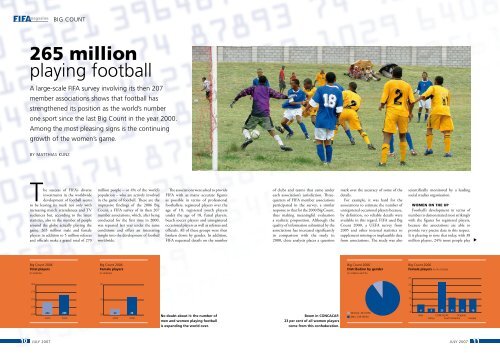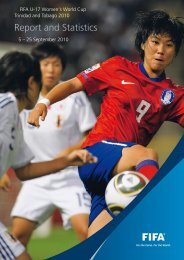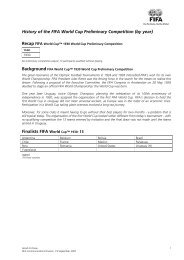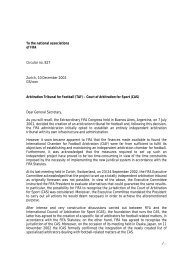265 million playing football - FIFA.com
265 million playing football - FIFA.com
265 million playing football - FIFA.com
You also want an ePaper? Increase the reach of your titles
YUMPU automatically turns print PDFs into web optimized ePapers that Google loves.
10<br />
magazine<br />
300<br />
275<br />
250<br />
225<br />
200<br />
242 <strong>265</strong><br />
2000<br />
BIG COUNT<br />
<strong>265</strong> <strong>million</strong><br />
<strong>playing</strong> <strong>football</strong><br />
A large-scale <strong>FIFA</strong> survey involving its then 207<br />
member associations shows that <strong>football</strong> has<br />
strengthened its position as the world’s number<br />
one sport since the last Big Count in the year 2000.<br />
Among the most pleasing signs is the continuing<br />
growth of the women’s game.<br />
BY MATTHIAS KUNZ<br />
The success of <strong>FIFA</strong>’s diverse<br />
investments in the worldwide<br />
development of <strong>football</strong> seems<br />
to be leaving its mark not only with<br />
increasing match attendances and TV<br />
audiences but, according to the latest<br />
statistics, also in the number of people<br />
around the globe actually <strong>playing</strong> the<br />
game. <strong>265</strong> <strong>million</strong> male and female<br />
players in addition to 5 <strong>million</strong> referees<br />
and offi cials make a grand total of 270<br />
Big Count 2006<br />
Total players<br />
(in <strong>million</strong>s)<br />
2006<br />
<strong>million</strong> people – or 4% of the world’s<br />
population – who are actively involved<br />
in the game of <strong>football</strong>. Th ese are the<br />
impressive fi ndings of the 2006 Big<br />
Count, a <strong>FIFA</strong> survey of its then 207<br />
member associations, which, after being<br />
conducted for the fi rst time in 2000,<br />
was repeated last year under the same<br />
conditions and off ers an interesting<br />
insight into the development of <strong>football</strong><br />
worldwide.<br />
Big Count 2006<br />
Female players<br />
(in <strong>million</strong>s)<br />
30<br />
25<br />
20<br />
22<br />
2000<br />
26<br />
2006<br />
Th e associations were asked to provide<br />
<strong>FIFA</strong> with as many accurate fi gures<br />
as possible in terms of professional<br />
<strong>football</strong>ers, registered players over the<br />
age of 18, registered youth players<br />
under the age of 18, futsal players,<br />
beach soccer players and unregistered<br />
occasional players as well as referees and<br />
offi cials. All of these groups were then<br />
broken down by gender. In addition,<br />
<strong>FIFA</strong> requested details on the number<br />
No doubt about it: the number of<br />
men and women <strong>playing</strong> <strong>football</strong><br />
is expanding the world over.<br />
of clubs and teams that came under<br />
each association’s jurisdiction. Th reequarters<br />
of <strong>FIFA</strong> member associations<br />
participated in the survey, a similar<br />
response to that for the 2000 Big Count,<br />
thus making meaningful evaluation<br />
a realistic proposition. Although the<br />
quality of information submitted by the<br />
associations has increased signifi cantly<br />
in <strong>com</strong>parison with the study in<br />
2000, close analysis places a question<br />
Boom in CONCACAF:<br />
23 per cent of all women players<br />
<strong>com</strong>e from this confederation.<br />
mark over the accuracy of some of the<br />
details.<br />
For example, it was hard for the<br />
associations to estimate the number of<br />
unregistered occasional players because,<br />
by defi nition, no reliable details were<br />
available in this regard. <strong>FIFA</strong> used Big<br />
Count 2000, a UEFA survey from<br />
2005 and other internal statistics to<br />
supplement missing or implausible data<br />
from associations. Th e study was also<br />
Big Count 2006<br />
Distribution by gender<br />
(in <strong>million</strong>s and %)<br />
JULY 2007 JULY 2007<br />
Women: 26 (10%)<br />
Men: 239 (90%)<br />
scientifi cally monitored by a leading<br />
social studies organisation.<br />
WOMEN ON THE UP<br />
Football’s development in terms of<br />
numbers is demonstrated most strikingly<br />
with the fi gures for registered players,<br />
because the associations are able to<br />
provide very precise data in this respect.<br />
It is pleasing to note that today, with 38<br />
<strong>million</strong> players, 24% more people play<br />
Big Count 2006<br />
Female players (in % of total)<br />
25<br />
20<br />
15<br />
10<br />
5<br />
0<br />
6 3 23 11 10 10<br />
Asia<br />
CONCACAF Oceania<br />
Africa South America Europe<br />
11
12<br />
magazine<br />
BIG COUNT<br />
under the umbrella of an association than<br />
did in 2000. Breaking the results down,<br />
the increase in number of registered female<br />
players is especially notable: 4.1 <strong>million</strong><br />
women are now <strong>playing</strong> <strong>football</strong> within<br />
organised structures, constituting a 54%<br />
increase on the 2000 results. Th is merely<br />
goes to substantiate the <strong>FIFA</strong> President<br />
Joseph S. Blatter’s prediction that: “Th e<br />
future of <strong>football</strong> is feminine.”<br />
Continuing to look to the future, one<br />
especially important statistic that can be<br />
drawn from the number of registered<br />
players is the proportion made up by<br />
youngsters, who constitute 54.7% of all<br />
registered male players and as many as<br />
69.6% of the women. Th e greater number<br />
of young players in the women’s game is<br />
a refl ection of the impressive growth in<br />
women’s <strong>football</strong>, which has also resulted<br />
in a signifi cant increase in the number<br />
Asia leads the fi eld among men and women.<br />
Big Count 2006<br />
Players by region<br />
(in <strong>million</strong>s and %)<br />
Africa (46 = 17%)<br />
North, Central America & Carribbean (43 = 16%)<br />
South America (28 = 11%)<br />
Oceania (0.5 = 0%)<br />
Europe (62 = 23%)<br />
Asia (85 = 33%)<br />
TOTAL NO. OF PLAYERS (in 1000s)<br />
1 Chinese Football Association (CHN) 26,166<br />
2 US Soccer Federation (USA) 24,473<br />
3 All India Football Federation (IND) 20,588<br />
4 Deutscher Fussball-Bund (GER) 16,309<br />
5 Confederaçao Brasileira de Futebol (BRA) 13,198<br />
6 Federación Mexicana de Fútbol Asociación, A.C. (MEX) 8,480<br />
7 Football Association of Indonesia (IDN) 7,094<br />
8 Nigeria Football Association (NGA) 6,654<br />
9 Bangladesh Football Federation (BAN) 6,280<br />
10 Football Union of Russia (RUS) 5,803<br />
of registered amateur players (up 138%<br />
<strong>com</strong>pared to 16% in the men’s game).<br />
Th ese fi gures clearly indicate that <strong>FIFA</strong><br />
and its member associations are on the<br />
right track to increasing the popularity of<br />
<strong>football</strong> even further in the future.<br />
Interesting conclusions about the<br />
development of <strong>football</strong> in the longer<br />
term can be drawn by <strong>com</strong>paring the<br />
latest fi ndings with statistics from 1974,<br />
when Dr Joao Havelange was fi rst elected<br />
<strong>FIFA</strong> President and only 140 associations<br />
were affi liated to <strong>FIFA</strong>. In the 33 years<br />
since, the number of male and female<br />
<strong>football</strong>ers registered worldwide has more<br />
than doubled from 17 <strong>million</strong> to around<br />
38 <strong>million</strong>.<br />
In addition to the registered players,<br />
who are relatively easy to quantify, the Big<br />
Count also includes the many <strong>football</strong>ers<br />
who are not registered with a club but<br />
10<br />
9<br />
8<br />
7<br />
6<br />
5<br />
4<br />
3<br />
2<br />
1<br />
0<br />
still take enjoyment from <strong>playing</strong> the<br />
game, in other words, the unregistered<br />
occasional players. Assembling some 226<br />
<strong>million</strong> people, this is the largest category<br />
and here too, male <strong>football</strong>ers make up<br />
the lion’s share (204 <strong>million</strong> or 90%), but<br />
the growth in the number of unregistered<br />
female players since 2000 is far greater<br />
than that of their male counterparts (up<br />
14% <strong>com</strong>pared to a 6% increase among<br />
the men).<br />
MORE TEAMS PER CLUB<br />
Another notable trend is evident in<br />
terms of club and team numbers. While<br />
the number of clubs – over 300,000<br />
– is much the same as it was in 2000,<br />
the number of teams – 1.7 <strong>million</strong> – has<br />
grown by around 12%. Whereas the<br />
average club had fi ve teams seven years<br />
ago, it now boasts seven. Organised<br />
Big Count 2006<br />
Total players by region (in % of total population)<br />
4 2,2 4,8 7,4 7,4 4,7 7,3<br />
World<br />
Africa South America Europe<br />
Asia CONCACAF Oceania<br />
TOTAL NO. OF PLAYERS (in % of population)<br />
1 Federación Costarricense de Fútbol (CRC) 27<br />
2 Deutscher Fussball-Bund (GER) 20<br />
3 The Faroe Islands Football Association (FRO) 17<br />
4 Federación Nacional de Fútbol de Guatemala (GUA) 16<br />
5 Federación de Fútbol de Chile (CHI) 16<br />
6 Asociación Paraguaya de Fútbol (PAR) 16<br />
7 Arubaanse Voetbal Bond (ARU) 15<br />
8 Barbados Football Association (BRB) 13<br />
9 Vanuatu Football Federation (VAN) 13<br />
10 Fédération Malienne de Football (MLI) 12<br />
REGISTERED NO. OF PLAYERS (in 1000s)<br />
1 Deutscher Fussball-Bund (GER) 6,309<br />
2 US Soccer Federation (USA) 4,187<br />
3 Confederaçao Brasileira de Futebol (BRA) 2,142<br />
4 Fédération Française de Football (FRA) 1,795<br />
5 Federazione Italiana Giuoco Calcio (ITA) 1,514<br />
6 The Football Association (ENG) 1,486<br />
7 South African Football Association (RSA) 1,469<br />
8 Koninklijke Nederlandse Voetbalbond (NED) 1,139<br />
9 Japan Football Association (JPN) 1,045<br />
10 The Canadian Soccer Association (CAN) 866<br />
REGISTERED NO. OF MALE PLAYERS (in 1000s)<br />
1 Deutscher Fussball-Bund (GER) 5,438<br />
2 US Soccer Federation (USA) 2,517<br />
3 Confederaçao Brasileira de Futebol (BRA) 2,115<br />
4 Fédération Française de Football (FRA) 1,746<br />
5 Federazione Italiana Giuoco Calcio (ITA) 1,499<br />
6 South African Football Association (RSA) 1,463<br />
7 The Football Association (ENG) 1,389<br />
8 Koninklijke Nederlandse Voetbalbond (NED) 1,055<br />
9 Japan Football Association (JPN) 1,000<br />
10 Football Union of Russia (RUS) 835<br />
REGISTERED NO. OF FEMALE PLAYERS (in 1000s)<br />
1 US Soccer Federation (USA) 1,670<br />
2 Deutscher Fussball-Bund (GER) 871<br />
3 The Canadian Soccer Association (CAN) 495<br />
4 Svenska Fotbollförbundet (SWE) 136<br />
5 Football Federation Australia Limited (AUS) 112<br />
6 Norges Fotballforbund (NOR) 98<br />
7 The Football Association (ENG) 97<br />
8 Koninklijke Nederlandse Voetbalbond (NED) 84<br />
9 Dansk Boldspil-Union (DEN) 56<br />
10 Fédération Française de Football (FRA) 49<br />
Millions are trying to emulate<br />
Brazil’s national hero Kaka.<br />
JULY 2007 JULY 2007<br />
13
14<br />
magazine<br />
BIG COUNT<br />
Big Count: statistical summary report by gender/category/region<br />
In 1000s; sum of rounded values does not always correspond with rounded total. Values proved statistically<br />
TOTAL AFC CAF CONCACAF CONMEBOL OFC UEFA<br />
Players 264,552 85,176 46,300 43,109 27,778 542 61,647<br />
Male 238,557 80,075 44,940 33,071 24,703 486 55,283<br />
Female 25,995 5,102 1,361 10,038 3074 56 6,364<br />
Referees, Offi cials 5,058 673 630 1133 168 32 2,422<br />
Total involved in <strong>football</strong> 269,610 85,849 46,930 44,242 27,946 573 64,069<br />
% of population 4.13 2.22 5.16 8.53 7.47 4.68 7.59<br />
Total population 6,529,791 3,870,439 909,575 518,613 374,235 12,252 844,677<br />
Registered players 38,287 4,040 3,101 6,121 3,759 241 21,025<br />
Professionals 113 11 7 9 25 0 60<br />
Amateurs (18 and over) 15,481 1,531 926 884 980 59 11,101<br />
Youth (under 18) 21,548 2,322 2,156 5,163 2,346 175 9,386<br />
Futsal 1,112 166 10 60 406 7 464<br />
Beach Soccer 33 10 2 5 1 0 14<br />
Unregistered players 226,<strong>265</strong> 81,136 43,199 36,988 24,018 301 40,622<br />
Company or army teams, schools<br />
and universities, street <strong>football</strong><br />
104,928 29,131 9,050 25,978 14,199 158 26,412<br />
occasional players,<br />
additional estimate<br />
121,337 52,006 34,149 11,010 9,819 143 14,210<br />
Referees, offi cials 5,058 673 630 1133 168 32 2,422<br />
Referees and assistant referees 843 263 50 172 32 3 322<br />
administrators, coaches,<br />
technical and medical staff<br />
4,214 410 580 961 136 29 2,100<br />
Clubs 301 20 12 17 47 2 202<br />
Teams 1,752 145 71 490 162 13 872<br />
Clubs with at least one women‘s team 26 3 1 7 1 0 13<br />
Big Count:<br />
Comparison 2006 – 2000 (in <strong>million</strong>s, overall totals rounded)<br />
Big Count 2006 Big Count 2000 +/-<br />
Total players <strong>265</strong> 242 +9%<br />
Male players 238.6 220.5 +8<br />
Female players 26.0 21.9 +19<br />
Total players, registered 38 31 +24%<br />
Male players, registered 34.2 28.3 +21<br />
Female players, registered 4.1 2.7 +54<br />
Total players, not registered 226 211 +7%<br />
Male players, not registered 204.4 192.2 +6<br />
Female players, not registered 21.9 19.2 +14<br />
Total youth 22 18 +7%<br />
Male players, youth 18.7 15.8 +18<br />
Female players, youth 2.9 2.2 +32<br />
Total Persons involved in <strong>football</strong> 270 247 +9%<br />
Total players 264.6 242.4 +9<br />
Total referees 0.84 0.72 +17<br />
Offi cials 4.2 3.6 +17<br />
<strong>football</strong> is therefore growing primarily<br />
within existing clubs. Moreover, around<br />
26,000 or 9% of all clubs fi eld at least one<br />
women’s team.<br />
FURTHER DEVELOPMENT<br />
As the information for Big Count<br />
was gathered by the associations, it is<br />
possible for analysis to be conducted not<br />
only at national level but also according<br />
to confederation. In recent years, the<br />
development of <strong>football</strong> has progressed<br />
at very diff erent speeds in the various<br />
continents. As regards actual numbers,<br />
Asia with 85 <strong>million</strong> <strong>football</strong>ers is well<br />
ahead of the other continents (Europe<br />
62 <strong>million</strong>, Africa 46, North and Central<br />
America 43, South America 28, Oceania<br />
0.5). However, if the number of players<br />
is calculated as a proportion of the total<br />
population, the CONCACAF and<br />
CONMEBOL regions lead the way, both<br />
with an active <strong>football</strong>ing population that<br />
makes up 7.4% of the entire population,<br />
closely followed by UEFA with 7.3%.<br />
Th ese statistics reiterate the special<br />
importance of <strong>football</strong> in Europe and<br />
the Americas and show that, in Asia and<br />
Oceania in particular, there is defi nitely<br />
room for further development in terms<br />
of the number of people <strong>playing</strong> the<br />
game.<br />
Th e confederations that show<br />
the highest growth rates are UEFA,<br />
CONMEBOL and CAF. In each of these<br />
three regions, the number of active players<br />
has grown by more than 10% since 2000,<br />
with women’s <strong>football</strong> (which, in Africa<br />
in particular, had been in very much<br />
a fl edgling state back then) recording<br />
especially positive development.<br />
WHAT DOES THE FUTURE HOLD?<br />
Th e 2006 Big Count clearly underlines<br />
the ongoing growth in the popularity<br />
of <strong>football</strong> worldwide. Th e increasing<br />
interest in the game, particularly among<br />
women and at youth level, bears witness<br />
to the hard work undertaken by <strong>FIFA</strong><br />
and its 207 member associations of<br />
late. Th is development work already<br />
appears to have borne fruit but the<br />
potential is far from being exploited to<br />
the full. By staging the fi rst <strong>FIFA</strong> U-17<br />
Women’s World Cup in New Zealand<br />
next year, <strong>FIFA</strong> is taking another step to<br />
take the game to the world. Th e game’s<br />
development in Africa is a further reason<br />
for excitement, but can <strong>football</strong> on the<br />
African continent hit new heights thanks<br />
to the 2010 <strong>FIFA</strong> World Cup in South<br />
Africa? All will be revealed in the next<br />
Big Count.<br />
Note from the editor: the August issue of<br />
<strong>FIFA</strong> magazine will contain <strong>com</strong>prehensive<br />
details of the Big Count including<br />
information from all of <strong>FIFA</strong>’s member<br />
associations.<br />
DPR Korea’s women players have earned a<br />
breakthrough into the elite.<br />
PHOTOS: FOTO-NET (2), IMAGO (2)<br />
Big Count 2006<br />
Registered players<br />
(in <strong>million</strong>s)<br />
JULY 2007 JULY 2007<br />
40<br />
35<br />
30<br />
31<br />
2000<br />
38<br />
2006<br />
TOTAL YOUTH (in 1000s)<br />
1 US Soccer Federation (USA) 3,907<br />
2 Deutscher Fussball-Bund (GER) 2,082<br />
3 Confederaçao Brasileira de Futebol (BRA) 1,347<br />
4 South African Football Association (RSA) 1,300<br />
5 Fédération Française de Football (FRA) 1,034<br />
6 The Football Association (ENG) 820<br />
7 The Canadian Soccer Association (CAN) 716<br />
8 Football Federation of Ukraine (UKR) 659<br />
9 Japan Football Association (JPN) 629<br />
10 Federazione Italiana Giuoco Calcio (ITA) 557<br />
MALE YOUTH (in 1000s)<br />
1 US Soccer Federation (USA) 2,344<br />
2 Deutscher Fussball-Bund (GER) 1,845<br />
3 Confederaçao Brasileira de Futebol (BRA) 1,345<br />
4 South African Football Association (RSA) 1,300<br />
5 Fédération Française de Football (FRA) 1,006<br />
6 The Football Association (ENG) 750<br />
7 Football Federation of Ukraine (UKR) 658<br />
8 Japan Football Association (JPN) 604<br />
9 Federazione Italiana Giuoco Calcio (ITA) 554<br />
10 Koninklijke Nederlandse Voetbalbond (NED) 467<br />
FEMALE YOUTH (in 1000s)<br />
1 US Soccer Federation (USA) 1,563<br />
2 The Canadian Soccer Association (CAN) 407<br />
3 Deutscher Fussball-Bund (GER) 237<br />
4 Svenska Fotbollförbundet (SWE) 107<br />
5 Football Federation Australia Limited (AUS) 84<br />
6 Norges Fotballforbund (NOR) 83<br />
7 The Football Association (ENG) 70<br />
8 Koninklijke Nederlandse Voetbalbond (NED) 43<br />
9 Dansk Boldspil-Union (DEN) 42<br />
10 Fédération Française de Football (FRA) 28<br />
Big Count 2006<br />
Referees<br />
(in 1,000s)<br />
1000<br />
900<br />
800<br />
700<br />
600<br />
500<br />
720 840<br />
2000 2006<br />
15

















